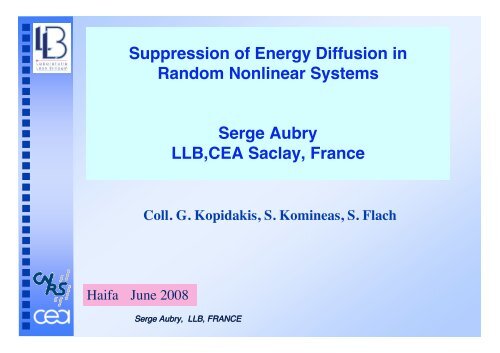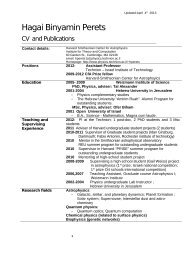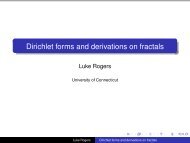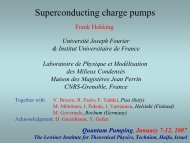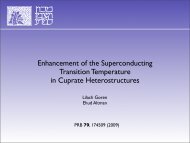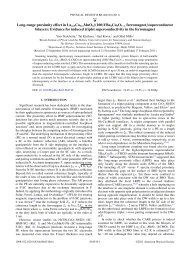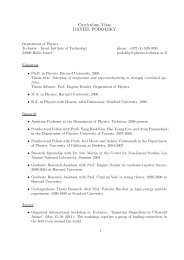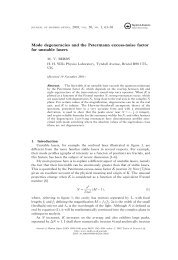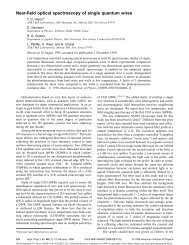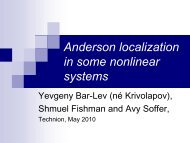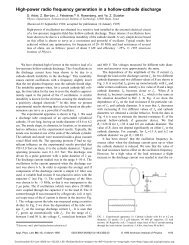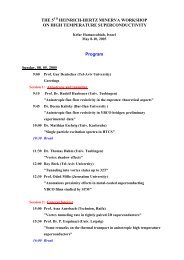Serge Aubry - Physics Department . Technion
Serge Aubry - Physics Department . Technion
Serge Aubry - Physics Department . Technion
You also want an ePaper? Increase the reach of your titles
YUMPU automatically turns print PDFs into web optimized ePapers that Google loves.
Suppression of Energy Diffusion in<br />
Random Nonlinear Systems<br />
Haifa June 2008<br />
<strong>Serge</strong> <strong>Aubry</strong><br />
LLB,CEA Saclay, France<br />
Coll. G. Kopidakis, S. Komineas, S. Flach<br />
<strong>Serge</strong> <strong>Aubry</strong>, <strong>Aubry</strong>,<br />
LLB, FRANCE
What is the long time behavior of an initially localized wavepacket<br />
1-Does it spread to zero amplitude (diffusion)?<br />
2- does it remain localized (absence of diffusion)?<br />
3- Does a part of the energy spread and another part remains localized?<br />
The answer is known in linear systems<br />
Diffusion if the linear spectrum is continuous<br />
Absence of diffusion when the linear spectrum is purely discrete<br />
(for example in disordered systems with Anderson localization)<br />
Nonlinear systems?<br />
<strong>Serge</strong> <strong>Aubry</strong>, <strong>Aubry</strong>,<br />
LLB, FRANCE
I-Nonlinear spatially periodic systems:<br />
(with no disorder)<br />
Incomplete diffusion of a wavepacket<br />
Possible formation of Discrete Breathers<br />
(spatially localized time periodic solutions)<br />
Sievers and Takeno 1988 (ILM)<br />
Campbell and Peyrard 1990 (Discrete Breathers-DBs)<br />
Generic Nonlinear Excitations (non restricted to<br />
special integrable models)<br />
in 1D, 2D, 3D… periodic arrays of nonlinear oscillators<br />
<strong>Serge</strong> <strong>Aubry</strong>, <strong>Aubry</strong>,<br />
LLB, FRANCE
Examples: Klein-Gordon systems 1,2 or 3D<br />
(anharmonic oscillators coupled by harmonic springs<br />
FPU systems (with gapless accoustic phonons)<br />
<strong>Serge</strong> <strong>Aubry</strong>, <strong>Aubry</strong>,<br />
LLB, FRANCE<br />
nonlinear springs<br />
The system at infinity behaves like linear and generate<br />
an effective frequency dependant damping on the dynamics<br />
Filtering the resonant components<br />
(Consequence:no damping for Discrete Breathers)<br />
Discrete Breathers may be dynamical ATTRACTORS<br />
in INFINITE Hamiltonian systems
Initial wavepacket<br />
Time periodic<br />
solution<br />
Initial<br />
Spontaneous Formation of a<br />
DISCRETE BREATHER<br />
no radiation<br />
Limit<br />
<strong>Serge</strong> <strong>Aubry</strong>, <strong>Aubry</strong>,<br />
LLB, FRANCE<br />
Sievers and Takeno (1988):<br />
from a initial localized wavepacket<br />
radiation<br />
Chaotic or « quasiperiodic »<br />
transient<br />
Transient<br />
radiation<br />
A large part of the initial energy<br />
remains localized as a DB, the rest<br />
spreads to zero at infinity<br />
The second moment diverges but<br />
the participation number does not
Existence proofs od Discrete Breathers (spatially localized<br />
Time periodic solutions)<br />
Existence Proofs of DBs in many nonlinear models<br />
1- by the Principle of Anticontinuity<br />
(MacKay SA 1994 Klein-Gordon<br />
2- Bambusi 1996<br />
3- Livi Mackay Spicci 1997 dimer FPU<br />
4- SA 1998<br />
5- SA, Kopidakis and Kadelburg 2001 (Variational)<br />
Arioli Gazola<br />
6- G. James 2003<br />
<strong>Serge</strong> <strong>Aubry</strong>, <strong>Aubry</strong>,<br />
LLB, FRANCE
II- Exact Time Periodic Solutions (Intraband Discrete Breathers)<br />
in Random and Nonlinear Systems<br />
(with linear Anderson lOCALIZATION)<br />
Kopidakis <strong>Aubry</strong> 1999-2000<br />
Random systems: When the linear spectrum is discrete.<br />
(Anderson localization) no linear phonon radiation is possible<br />
Existence Proofs of Intraband DBs (IDBs)<br />
Theorem: Albanèse and Frohlich 1991<br />
Anderson modes persist in nonlinear models as time periodic<br />
solutions with frequencies in a fat Cantor set.<br />
Numerical Calculations (at computer accuracy) of intraband<br />
Discrete Breathers : KA 1999-2000<br />
1- Quasi-continuation in L 2 : Each Anderson mode generates a family<br />
of IDBs with frequency in a FAT CANTOR SET (with nonvanishing measure)<br />
2- Continuation in L ∞ : Each Anderson mode becomes an extended multiDB<br />
with infinite energy<br />
<strong>Serge</strong> <strong>Aubry</strong>, <strong>Aubry</strong>,<br />
LLB, FRANCE
Fat Cantor Set<br />
(finite Lebesgue measure)<br />
(Pseudo)continuation of an Anderson mode<br />
at nonvanishing amplitude (scheme)<br />
Nonlinear modes disappears in a small frequency gap at each resonance<br />
Nonlinear <strong>Serge</strong> <strong>Aubry</strong>, <strong>Aubry</strong> modes , LLB, avoid FRANCE<br />
resonances<br />
frequency
Numerical Calculation of Localized Time periodic<br />
Solutions<br />
Using the Nonlinear Response Manifold to a Localized Time<br />
Periodic Driving Force<br />
Calculate the time periodic solution u n(t) at frequency<br />
versus the driving force F (using Newton method)<br />
F small linear response.<br />
The response is smooth for most<br />
<strong>Serge</strong> <strong>Aubry</strong>, <strong>Aubry</strong>,<br />
LLB, FRANCE
Projection of<br />
NLRM<br />
KA 2000<br />
<strong>Serge</strong> <strong>Aubry</strong>, <strong>Aubry</strong>,<br />
LLB, FRANCE
RDNLS: a straightforward proof of existence<br />
for Time Periodic Extended States<br />
<strong>Serge</strong> <strong>Aubry</strong>, <strong>Aubry</strong>,<br />
LLB, FRANCE<br />
Periodic solutions<br />
are extrema of<br />
When the ground-state corresponds to a<br />
(linearly stable) extended solution (but many other extrema)
III- Exact Quasiperiodic Solutions<br />
in Random Nonlinear Systems<br />
Some exact Results<br />
Fröhlich Spencer Wayne (1986) for<br />
random Hamiltonian Systems with pair interactions<br />
Bourgain Wang (2008) for RDNLS<br />
W. Craig yet unpublished (?) for RDNLS<br />
<strong>Serge</strong> <strong>Aubry</strong>, <strong>Aubry</strong>,<br />
LLB, FRANCE
Anderson Representation of DNLS<br />
norm current p —> p’<br />
<strong>Serge</strong> <strong>Aubry</strong>, <strong>Aubry</strong>,<br />
LLB, FRANCE<br />
New complex variables
Almost Periodic Solutions:<br />
Fröhlich, Spencer, Wayne (1986)<br />
Assume<br />
C p,p’ depends only on µ p and µ p’ (pair interactions)<br />
Then, with large probability, there are quasiperiodic lattice<br />
vibrations of finite total energy which lie on some infinitedimensional,<br />
compact invariant tori in phase space.<br />
<strong>Serge</strong> <strong>Aubry</strong>, <strong>Aubry</strong>,<br />
LLB, FRANCE
Quasiperiodic Periodic Solutions:<br />
Bourgain Wang (2008)<br />
In random DNLS, there are quasiperiodic solution<br />
corresponding to finite dimension invariant tori<br />
Almost periodic Periodic Solutions:<br />
Walter Craig (private communication)<br />
In random DNLS, there are « many » almost periodic solutions<br />
corresponding to infinite dimension invariant tori<br />
(use of Nash-Moser method?)<br />
<strong>Serge</strong> <strong>Aubry</strong>, <strong>Aubry</strong>,<br />
LLB, FRANCE
Assume p random in interval B<br />
Probability of resonance at lowest order (leading order)<br />
Assume
The probability to find an initial wave packet which<br />
evolves almost periodically, is large and goes to one as<br />
the norm of the wave packet goes to zero<br />
What about the wavepacket which are initially resonant?<br />
<strong>Serge</strong> <strong>Aubry</strong>, <strong>Aubry</strong>,<br />
LLB, FRANCE
quadratic<br />
IV Rigorous Results for DNLS Hamiltonians<br />
proving the absence of complete diffusion of<br />
a large enough Wavepacket<br />
with invariance by phase rotation<br />
(implies norm l 2 conservation)<br />
<strong>Serge</strong> <strong>Aubry</strong>, <strong>Aubry</strong>,<br />
LLB, FRANCE<br />
Nonlinear higher order<br />
H NL > 0 strictly positive<br />
(or negative)
Assume the wavepacket spreads uniformy to zero:<br />
(lim t=∞ ||Ψ|| ∞ =0 ),<br />
then at infinite time the nonlinear contribution H NL to the<br />
energy is zero since<br />
and the norm ||Ψ|| 2 is time constant. Then<br />
energy cannot be<br />
conserved and consequently the wave packet cannot<br />
spread uniformly to zero.<br />
Since the higher order nonlinear energy grows faster<br />
than the norm the wavepacket cannot spread uniformly<br />
to zero when its amplitude is large enough<br />
<strong>Serge</strong> <strong>Aubry</strong>, <strong>Aubry</strong>,<br />
LLB, FRANCE
A family of models without diffusion<br />
(random or not random) :<br />
DNLS Models with Dispersionless Linear Phonons<br />
H L is time constant, then H NL is time constant<br />
Any initial l 2 wavepacket cannot spread to zero<br />
independantly whether there is disorder or not<br />
<strong>Serge</strong> <strong>Aubry</strong>, <strong>Aubry</strong>,<br />
LLB, FRANCE
Example:<br />
What is the behavior of a wavepacket if no spreading to zero<br />
is possible.<br />
(periodic case: independant of n:<br />
generation of mobile Discrete Breathers (« Discrete<br />
Compactons ») which radiates wavelets and stops<br />
(numerically observed for periodic systems by S. Flach)<br />
Consequence: The limit profile is quasiperiodic.<br />
Random case: Same conjecture<br />
<strong>Serge</strong> <strong>Aubry</strong>, <strong>Aubry</strong>,<br />
LLB, FRANCE
In the Anderson base same model, the random DNLS<br />
Model belong to this family of<br />
NONdiffusive Hamiltonian except that operator L<br />
(though it is diagonal), is not proportional to unity<br />
but is random.<br />
Why extra randomness would generate diffusion?<br />
Conjecture: for RDNLS, the limit profile of any<br />
initially localized wavepacket should be or<br />
become quasiperiodic<br />
(as an infinite dimension invariant torus).<br />
<strong>Serge</strong> <strong>Aubry</strong>, <strong>Aubry</strong>,<br />
LLB, FRANCE
V Diffusion of a Wavepacket in nonlinear random<br />
Arrays: Early numerical investigation<br />
When linear modes are localized (Anderson localization)<br />
no diffusion but nonlinearity couples the linear Anderson modes<br />
Then, energy diffusion?<br />
Many early works conclude subdiffusion!<br />
Bourbonnay-Maynard (1990) (random FPU)<br />
Shepelyansky (1994), Molina (1997)…. (DNLS)<br />
Snyder-Kirpatrick(random FPU) (2006)<br />
Pikovsky-Shepeliansky(2008)<br />
Numerical investigation of the second moment versus time<br />
Diffusion is subcritical t α<br />
where α ~ 2/5 (Shepelyansky) … 0.27 (Molina) etc....<br />
<strong>Serge</strong> <strong>Aubry</strong>, <strong>Aubry</strong>,<br />
LLB, FRANCE
Subdiffusion was claimed only on<br />
the base of the second moment divergency<br />
(not clear numerically poorly defined exponents)<br />
Remark: Divergency of the second moment does not<br />
implies diffusion at all!!!!!<br />
Counter example: The second moment of a wavepacket<br />
in a linear harmonic chain of atoms coupled by<br />
random springs diverges as t 1/2<br />
but there is no diffusion because of Anderson localization<br />
Coll: Analytic estimations R. Schilling, S. Lepri and SA<br />
<strong>Serge</strong> <strong>Aubry</strong>, <strong>Aubry</strong>,<br />
LLB, FRANCE
There are initial conditions with no diffusion at all<br />
For example: Intraband discrete breathers<br />
Almost no diffusion (?) for small amplitude initial<br />
wavepacket or close to anticontinuous limit<br />
Quasiperiodic solutions?<br />
There are initial conditions with apparently initially<br />
strong diffusion (with strong chaos Shepelyansky)<br />
The most studied!!!<br />
<strong>Serge</strong> <strong>Aubry</strong>, <strong>Aubry</strong>,<br />
LLB, FRANCE
Conjectures for Infinite Nonlinear Arrays with linear Anderson<br />
Localization (purely discrete spectrum with no mobility threshold)<br />
There are two kinds of Initial Conditions which both may be obtained<br />
both with finite probability<br />
1- Solutions which are purely quasiperiodic from the begining (infinite<br />
dimension invariant tori). Their probability goes to 1 at small norm<br />
or close to the anticontinuous limit or close linearly stable IDB<br />
solutions.<br />
2-Solutions which are initially Chaotic but slowly converge to a<br />
quasiperiodic profile. Self-organization profile.<br />
Initial resonances are spontaneously removed by energy radiation<br />
through non excited Anderson modes which may generate a long tail.<br />
No Diffusion at all for any initial l 2 wave packet.<br />
<strong>Serge</strong> <strong>Aubry</strong>, <strong>Aubry</strong>,<br />
LLB, FRANCE
VI-New Numerical Investigations<br />
G. Kopidakis, S. Komineas, S. Flach and SA (PRL (2008))<br />
http://www.mpipks-dresden.mpg.de/pages/forschung/forschung_advanced.html<br />
Random DNLS Hamiltonian(2 invariants)<br />
Random Quartic Klein-Gordon Hamiltonian (1 invariant)<br />
<strong>Serge</strong> <strong>Aubry</strong>, <strong>Aubry</strong>,<br />
LLB, FRANCE<br />
Very similar behaviors
Energy density profile in the Anderson space<br />
(Quartic KG model)<br />
<strong>Serge</strong> <strong>Aubry</strong>, <strong>Aubry</strong>,<br />
LLB, FRANCE<br />
Few Anderson modes are and remains strongly excited<br />
V=0.25<br />
β=1<br />
W=4
<strong>Serge</strong> <strong>Aubry</strong>, <strong>Aubry</strong>,<br />
LLB, FRANCE<br />
t=1.2. 10 8 red<br />
Profile (log)<br />
In Anderson space<br />
(Quartic Klein Gordon model<br />
W=4<br />
In real space:<br />
random DNLS<br />
t=10 7 black<br />
t=2. 10 8 red
Participation number of norm distribution for the random DNLS model<br />
for different amplitudes of the single site initial wave packet<br />
<strong>Serge</strong> <strong>Aubry</strong>, <strong>Aubry</strong>,<br />
LLB, FRANCE
Participation number of norm distribution in Anderson space<br />
for the random DNLS model and for different amplitudes of<br />
the single Anderson mode initial wave packet<br />
<strong>Serge</strong> <strong>Aubry</strong>, <strong>Aubry</strong>,<br />
LLB, FRANCE
3 orders of magnitude<br />
longer time of evolutions<br />
<strong>Serge</strong> <strong>Aubry</strong>, <strong>Aubry</strong>,<br />
LLB, FRANCE<br />
Second moment<br />
Participation number<br />
The second moment<br />
versus time seems to diverge.<br />
The participation number<br />
does not!<br />
e n = energy density in<br />
Anderson space for KG<br />
e n =|Ψ n | 2 for DNLS
<strong>Serge</strong> <strong>Aubry</strong>, <strong>Aubry</strong>,<br />
LLB, FRANCE<br />
Time Fourier transform<br />
of the participation number<br />
The limit profile tends<br />
to be quasiperiodic!<br />
Same result for the time<br />
Fourier transform at a<br />
single central site
Numerical arguments for KAM tori as limit profile<br />
of an initially localized wavepacket<br />
1-The participation ratio of the energy distribution does not<br />
diverge.<br />
2- The amplitude of the at any site does not decay to zero<br />
though it oscillates indefinetely.<br />
3-The largest Lyapounov exponent initially drops by 2 or 3<br />
orders of magnitude while the wavepacket does not spread to<br />
small amplitude. It continues to decay but slower and slower.<br />
4- Simultaneously, the Fourier spectrum of the atomic motion<br />
near center from broad band becomes narrow band with thin<br />
line widths<br />
Conclusion: The attractor of the system (limit profile)<br />
might be a KAM tori ?<br />
but very slow convergence (Arnol’d diffusion?)<br />
What about the evolution for times beyond those numerically available?<br />
Need a mathematical proof?<br />
<strong>Serge</strong> <strong>Aubry</strong>, <strong>Aubry</strong>,<br />
LLB, FRANCE
Scenario for the Absence of spreading<br />
Limit profile at t= + ∞ of the energy density with long tail<br />
is quasiperiodic (nevertheless the second moment may diverge??!!!))<br />
<strong>Serge</strong> <strong>Aubry</strong>, <strong>Aubry</strong>,<br />
LLB, FRANCE<br />
Tail generation<br />
by weak excitation<br />
of Anderson modes
Finite size effects (numerically tested)<br />
For small system, the wave packet cannot spread out.<br />
No long tail can develop. Radiated energy from resonances<br />
remains confined and interacts again with the core of the wavepacket.<br />
Initial Chaos persists forever there is (roughly) energy equipartition<br />
after long enough time (unless the initial solution generates<br />
a KAM torus)<br />
For an infinite system the energy of the initial wave packet is not extensive<br />
and corresponds to zero temperature. It cannot thermalize.<br />
For an FINITE system, initial chaos of the wavepacket (if<br />
any) persist at any time while it spontaneously disappears<br />
for an INFINITE system. Then, the wavepacket<br />
slowly converges to a nonvanishing quasiperiodic limit<br />
profile.<br />
<strong>Serge</strong> <strong>Aubry</strong>, <strong>Aubry</strong>,<br />
LLB, FRANCE
Warning about the problem of reliability of numerical simulations for Long<br />
Time Evolution (Arnol’d diffusion regime)<br />
1-Nonlinear terms are responsible for energy exchanges between the Anderson<br />
modes. At small amplitudes, the system becomes nearly integrable because<br />
nonlinearities are weak. Thus, numerical noise becomes relatively important (with<br />
respect to the nonlinear terms) and could play the essential role for generating<br />
(small) energy diffusion.<br />
-2 A well-known similar problem of « Arnol’d diffusion » was encountered for the<br />
numerical integration of solar planetary systems. The problem was solved by using<br />
secular equations involving only slow variables (orbits parameters).<br />
With such techniques Jacques Laskar could integrate with controlled accuracy<br />
over 5. 10<br />
<strong>Serge</strong> <strong>Aubry</strong>, <strong>Aubry</strong>,<br />
LLB, FRANCE<br />
9 years solar system models using a step size of 200-500 years that is<br />
about only 107 integration steps (see J. Laskar Icarus 196 1-15 (2008)) (while<br />
ordinary techniques would require a step size of only 8 days!) and very short<br />
(reliable) runs.
Similarity with the problem of Chaotic diffusion in the<br />
Solar System.<br />
It is generally believed that at the beginning, the planet<br />
motions in the solar system were rather chaotic.<br />
After a long time, collisions and planet escapes spontaneously<br />
regularized the motions of the left planets to become<br />
« almost » quasiperiodic as today.<br />
However, weak chaos still persist today from the original one.<br />
It has been proved numerically for the motion of<br />
some planets like Mercury (e.g. see J. Laskar Icarus 196 1-<br />
15 (2008) and refs. ) using sophisticated methods where the<br />
numerical errors could be carefully controlled.<br />
<strong>Serge</strong> <strong>Aubry</strong>, <strong>Aubry</strong>,<br />
LLB, FRANCE
VII Summary and concluding remarks<br />
The possible divergency of the second moment does not implies energy spreading<br />
as believed in early publications.<br />
Numerical observations (over times which are not too long<br />
for the above reasons) shows<br />
1- There are initial conditions with practically no diffusion from the beginning<br />
(quasiperiodic?) and others which looks (initially) chaotic.<br />
2- the participation number does not (clearly) diverge in any case. Moreover,<br />
it is rigorously proven it cannot diverge in DNLS models with norm conservation<br />
and large enough amplitude wave packet.<br />
3- The same qualitative behavior for the spreading of an initially localized<br />
wavepacket in DNLS models with norm conservation and quartic KG models<br />
without norm conservation<br />
4-Conjecture: Unless the wavepacket corresponds initialy to a quasiperiodic<br />
solution, it converges (slowly) to a limit profile which is a quasiperiodic and<br />
spatially localized solution (KAM torus).<br />
This profile may not have second moment or may have a second moment?<br />
(open question)<br />
<strong>Serge</strong> <strong>Aubry</strong>, <strong>Aubry</strong>,<br />
LLB, FRANCE
Conjectures:: There should be absence of diffusion for any initially<br />
localized wave packet in any nonlinear model at any dimension<br />
with purely discrete linear spectrum (Random, quasiperiodic or else)<br />
There is diffusion (at least partial in case of time periodic Discrete Breather<br />
formation) in all models for which the linear spectrum has an absolutely<br />
continous component.<br />
There is diffusion as soon the model is a at non vanishing temperature<br />
or if it submitted to a random noise (with broad spectrum)<br />
Numerical problem with random FPU model: The linear localization<br />
length diverges at low frequency. The long tail already exists in the linear<br />
case (diverging second moment) and cannot be considered as an<br />
effect of nonlinearity<br />
<strong>Serge</strong> <strong>Aubry</strong>, <strong>Aubry</strong>,<br />
LLB, FRANCE<br />
Final Comments


